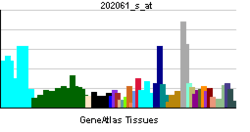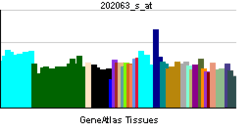SEL1L
| View/Edit Human | View/Edit Mouse |
Protein sel-1 homolog 1 is a protein that in humans is encoded by the SEL1L gene.[3][4][5][6]
Clinical relevance
A mutation in this gene in Finnish Hound dogs have been implicated in cases of cerebellar ataxia.[7] Mutant cells suffer disruptions in their endoplasmic reticula, leading to disease.
References
- ↑ "Human PubMed Reference:".
- ↑ "Mouse PubMed Reference:".
- ↑ Biunno I, Appierto V, Cattaneo M, Leone BE, Balzano G, Socci C, Saccone S, Letizia A, Della Valle G, Sgaramella V (Feb 1998). "Isolation of a pancreas-specific gene located on human chromosome 14q31: expression analysis in human pancreatic ductal carcinomas". Genomics. 46 (2): 284–6. doi:10.1006/geno.1997.5018. PMID 9417916.
- ↑ Donoviel DB, Bernstein A (Apr 1999). "SEL-1L maps to human chromosome 14, near the insulin-dependent diabetes mellitus locus 11". Genomics. 56 (2): 232–3. doi:10.1006/geno.1998.5534. PMID 10051412.
- ↑ Biunno I, Cattaneo M, Orlandi R, Canton C, Biagiotti L, Ferrero S, Barberis M, Pupa SM, Scarpa A, Ménard S (May 2006). "SEL1L a multifaceted protein playing a role in tumor progression". J Cell Physiol. 208 (1): 23–38. doi:10.1002/jcp.20574. PMID 16331677.
- ↑ "Entrez Gene: SEL1L sel-1 suppressor of lin-12-like (C. elegans)".
- ↑ Kyöstilä K, Cizinauskas S, Seppälä EH, Suhonen E, Jeserevics J, Sukura A, Syrjä P, Lohi H (2012). "A SEL1L Mutation Links a Canine Progressive Early-Onset Cerebellar Ataxia to the Endoplasmic Reticulum–Associated Protein Degradation (ERAD) Machinery". PLoS Genetics. 8 (6): e1002759. doi:10.1371/journal.pgen.1002759. PMC 3375262
 . PMID 22719266.
. PMID 22719266.
Further reading
- Donoviel DB, Donoviel MS, Fan E, Hadjantonakis A, Bernstein A (1999). "Cloning and characterization of Sel-1l, a murine homolog of the C. elegans sel-1 gene.". Mech. Dev. 78 (1–2): 203–7. doi:10.1016/S0925-4773(98)00146-4. PMID 9858735.
- Harada Y, Ozaki K, Suzuki M, Fujiwara T, Takahashi E, Nakamura Y, Tanigami A (1999). "Complete cDNA sequence and genomic organization of a human pancreas-specific gene homologous to Caenorhabditis elegans sel-1". J. Hum. Genet. 44 (5): 330–6. doi:10.1007/s100380050171. PMID 10496078.
- Biunno I, Bernard L, Dear P, Cattaneo M, Volorio S, Zannini L, Bankier A, Zollo M (2000). "SEL1L, the human homolog of C. elegans sel-1: refined physical mapping, gene structure and identification of polymorphic markers". Hum. Genet. 106 (2): 227–35. doi:10.1007/s004390051032. PMID 10746565.
- Orlandi R, Cattaneo M, Troglio F, Casalini P, Ronchini C, Ménard S, Biunno I (2002). "SEL1L expression decreases breast tumor cell aggressiveness in vivo and in vitro". Cancer Res. 62 (2): 567–74. PMID 11809711.
- Chiaramonte R, Sabbadini M, Balordi F, Comi P, Sherbet GV (2003). "Allele frequency of two intragenic microsatellite loci of SEL1L gene in Northern Italian population". Mol. Cell. Biochem. 232 (1–2): 159–61. doi:10.1023/A:1014828829621. PMID 12030374.
- Chiaramonte R, Calzavara E, Basile A, Comi P, Sherbet GV (2003). "Notch signal transduction is not regulated by SEL1L in leukaemia and lymphoma cells in culture". Anticancer Res. 22 (6C): 4211–4. PMID 12553058.
- Zhang H, Li XJ, Martin DB, Aebersold R (2003). "Identification and quantification of N-linked glycoproteins using hydrazide chemistry, stable isotope labeling and mass spectrometry". Nat. Biotechnol. 21 (6): 660–6. doi:10.1038/nbt827. PMID 12754519.
- Clark HF, Gurney AL, Abaya E, Baker K, Baldwin D, Brush J, Chen J, Chow B, Chui C, Crowley C, Currell B, Deuel B, Dowd P, Eaton D, Foster J, Grimaldi C, Gu Q, Hass PE, Heldens S, Huang A, Kim HS, Klimowski L, Jin Y, Johnson S, Lee J, Lewis L, Liao D, Mark M, Robbie E, Sanchez C, Schoenfeld J, Seshagiri S, Simmons L, Singh J, Smith V, Stinson J, Vagts A, Vandlen R, Watanabe C, Wieand D, Woods K, Xie MH, Yansura D, Yi S, Yu G, Yuan J, Zhang M, Zhang Z, Goddard A, Wood WI, Godowski P, Gray A (2003). "The secreted protein discovery initiative (SPDI), a large-scale effort to identify novel human secreted and transmembrane proteins: a bioinformatics assessment". Genome Res. 13 (10): 2265–70. doi:10.1101/gr.1293003. PMC 403697
 . PMID 12975309.
. PMID 12975309. - Cattaneo M, Canton C, Albertini A, Biunno I (2004). "Identification of a region within SEL1L protein required for tumour growth inhibition". Gene. 326: 149–56. doi:10.1016/j.gene.2003.10.021. PMID 14729273.
- Lilley BN, Ploegh HL (2006). "Multiprotein complexes that link dislocation, ubiquitination, and extraction of misfolded proteins from the endoplasmic reticulum membrane". Proc. Natl. Acad. Sci. U.S.A. 102 (40): 14296–301. doi:10.1073/pnas.0505014102. PMC 1242303
 . PMID 16186509.
. PMID 16186509. - Otsuki T, Ota T, Nishikawa T, Hayashi K, Suzuki Y, Yamamoto J, Wakamatsu A, Kimura K, Sakamoto K, Hatano N, Kawai Y, Ishii S, Saito K, Kojima S, Sugiyama T, Ono T, Okano K, Yoshikawa Y, Aotsuka S, Sasaki N, Hattori A, Okumura K, Nagai K, Sugano S, Isogai T (2007). "Signal sequence and keyword trap in silico for selection of full-length human cDNAs encoding secretion or membrane proteins from oligo-capped cDNA libraries". DNA Res. 12 (2): 117–26. doi:10.1093/dnares/12.2.117. PMID 16303743.
- Cattaneo M, Fontanella E, Canton C, Delia D, Biunno I (2006). "SEL1L affects human pancreatic cancer cell cycle and invasiveness through modulation of PTEN and genes related to cell-matrix interactions". Neoplasia. 7 (11): 1030–8. doi:10.1593/neo.05451. PMC 1502024
 . PMID 16331889.
. PMID 16331889. - Saltini G, Dominici R, Lovati C, Cattaneo M, Michelini S, Malferrari G, Caprera A, Milanesi L, Finazzi D, Bertora P, Scarpini E, Galimberti D, Venturelli E, Musicco M, Adorni F, Mariani C, Biunno I (2006). "A novel polymorphism in SEL1L confers susceptibility to Alzheimer's disease". Neurosci. Lett. 398 (1–2): 53–8. doi:10.1016/j.neulet.2005.12.038. PMID 16412574.
This article is issued from Wikipedia - version of the 12/3/2016. The text is available under the Creative Commons Attribution/Share Alike but additional terms may apply for the media files.


